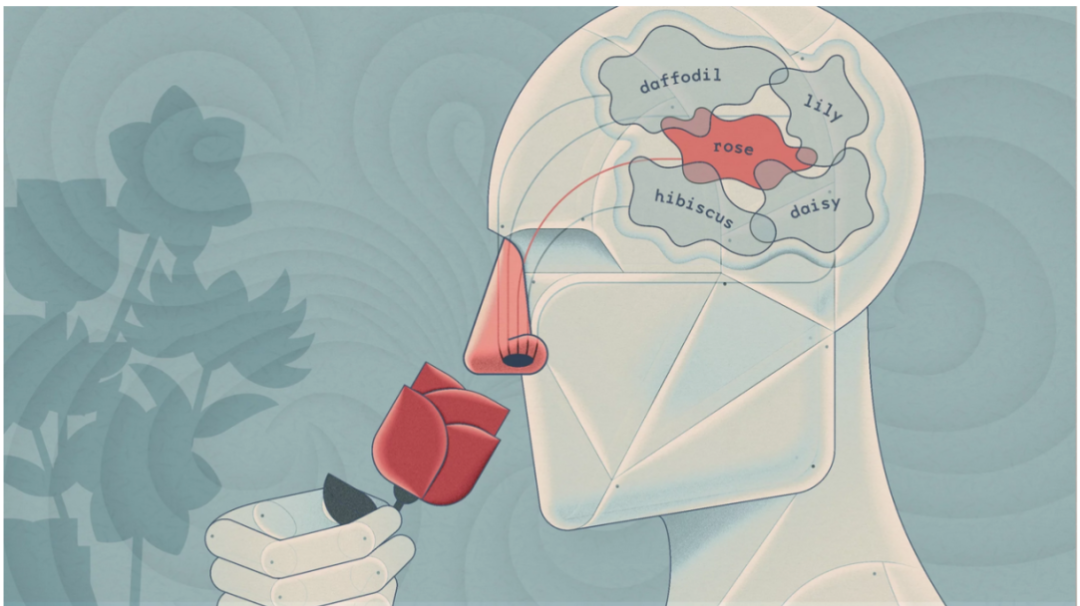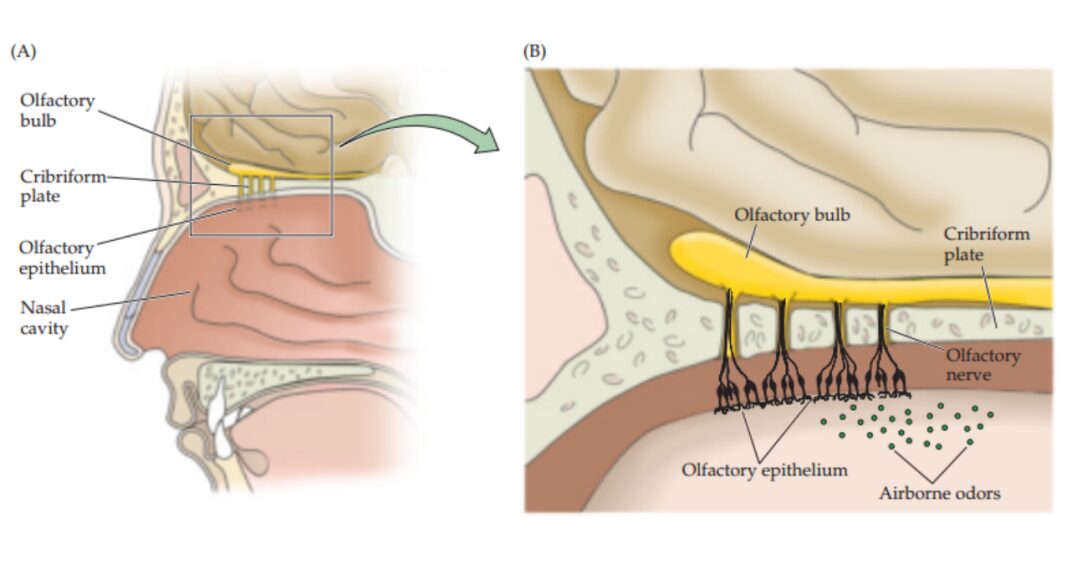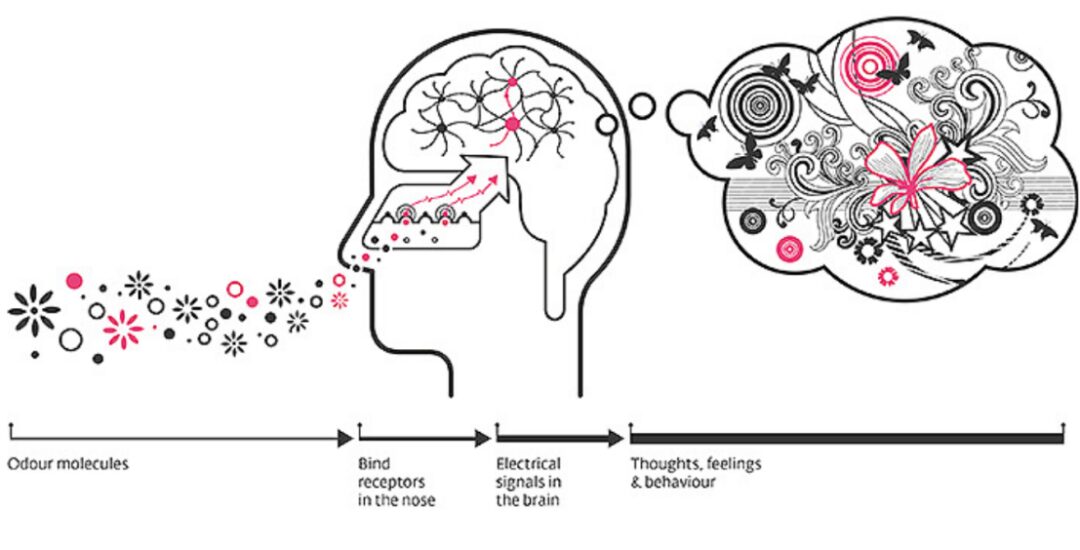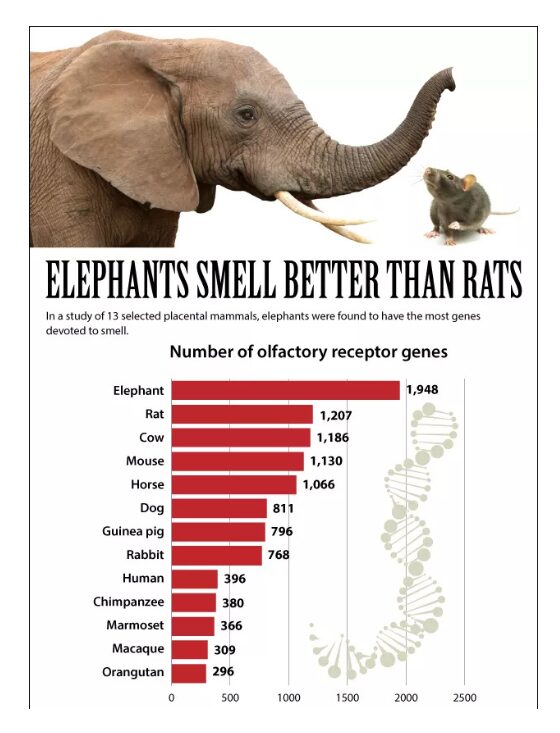ZHEJIANG GONGSHANG UNIVERSITY 浙江工商大学食品与生物工程学院

LABORATORY of FOOD ORAL PROCESSING,
ZHEJIANG GONGSHANG UNIVERSITY
食品口腔加工实验室(中国 · 杭州)
December 28, 2022
Sensory Physics 101 | Olfaction
Introduction
Humans have five basic senses, including vision, hearing, touch, smell, and taste, to help perceive the surrounding world. The associated body parts transmit sensations to the brain, which then transforms these sensations into information that the human body can comprehend through a complex and mysterious process. Bright colors, loud sounds, intense pain, familiar tastes on the tongue, or fragrant scents—all stimuli converge to create a picture that helps us identify our environment. The sensory system of the human body is very complex and mysterious; animals are no exception: felines are known for their night vision, elephants have the most sensitive sense of smell among animals, and bats rely on sound waves for hunting. Magnetoreception—the ability to detect the Earth’s magnetic field—is even considered a sixth sense that some birds, mammals, reptiles, and fish are believed to possess.
The Sensory Physics 101 series aims to explore the physical processes that constitute each sense (including the so-called sixth sense) and explain the extent to which they endow certain species with “superpowers.”
Olfactory perception, defined as “a process that begins with the stimulation of olfactory sensory neurons in the nasal cavity towards higher brain centers, which, when activated, allows us to consciously perceive a scent,” is crucial for survival. The natural environment is indeed filled with scents that enable animals to find food sources, identify mates, or evade predators[1]. From an evolutionary perspective, chemical senses, particularly olfaction, are considered the oldest sensory systems; however, they remain one of the least understood forms of sensation in many ways. We study the mechanisms of olfaction, explore its connections to memory and even disease detection, and introduce the capabilities olfaction provides to animals such as dogs, bears, and elephants.
1
Olfactory Discrimination
Human olfaction, like that of mammals, originates in the nasal cavity, which primarily functions to humidify and heat the air inhaled through the nostrils, filtering out small particles or debris before they reach the lower respiratory tract. The direct nasal airflow or retronasal airflow then delivers odorant particles to the olfactory epithelium at the top of the oral cavity. Individual receptor cells can only detect one type of odor and cannot regenerate, which is a unique feature of the olfactory system[2].

Figure 1 Olfactory Discrimination (Armitage, 2022)
2
Organization of the Human Olfactory System
The olfactory system is similar to other sensory systems in that it can recognize a wide range of stimuli. Its complexity lies in the diverse and difficult-to-define characteristics of odor substances. Since the 1950s, the most widely used classification studies have categorized odors into different types, “based on their perceptual quality, molecular structure, and the fact that some people, known as anosmics, find it difficult to smell one group of odors or another”[3]. This classification, including pungent, floral, musky, earthy, ethereal, camphoraceous, minty, etherous, and putrid odors, remains entirely empirical, although its longevity “suggests that the olfactory system can recognize odor types with different perceptual qualities.” Humans possess an exceptional olfactory discrimination ability, capable of distinguishing over a trillion stimuli, thanks to the combinatorial output of about 400 receptor subtypes (subtypes of receptors). This discrimination relies on the “combinatorial coding of multiple steps of olfactory processing and interactions at the circuit level,” which can be enhanced through learning[4]. Additionally, “the olfactory receptor subtype genomes of any two individuals differ by 30%”, indicating that each person may have a unique nose[5]. A study in 2015 indeed developed a highly sensitive perception test to capture the olfactory fingerprints displayed by each person through nearly unique olfactory genomes. This fingerprint was found to be odor-specific but did not rely on descriptors and showed potential in predicting immune modulation aspects, as well as revealing meaningful non-olfactory genetic information. Finally, the bond vibration-assisted olfactory theory suggests that human olfactory perception is influenced not by molecular shape but by the oscillations of electrons tunneling through energy gaps of receptors[6]. A recent study tested this hypothesis by using infrared light to excite the molecular bond oscillations in odor molecules and measuring their perceived differences, thanks to the spin-residual information contained in emitted infrared photons[7]. Twenty-three subjects were given a citrus and a musky scent under three different conditions (two infrared wavelengths and one non-infrared wavelength) and were asked to rate the intensity of olfactory perception for each inhalation. Researchers found that the intensity of the odors was influenced by external infrared illumination in each case, indicating that quantum spin-residuals indeed play a role in olfactory perception.
Enhanced olfaction has endowed retired nurse Joy Milne from Scotland with a special ability: she can identify the progression stages of Parkinson’s disease, the second most common neurodegenerative disorder[8]. She has worked with doctors and researchers to help a team at the University of Manchester develop a simple swab test that can detect Parkinson’s disease within three minutes[9]. Scientists have found that certain high molecular weight lipids are significantly more active in the sebum of Parkinson’s patients, and Milne could smell this scent in the upper back area of her husband. Under laboratory conditions, skin swab tests showed 95% accuracy, which could greatly improve the diagnosis and symptom management of Parkinson’s disease[10].

Figure 2 Organization of the Human Olfactory System (Purves et al, 2004)
3
Olfactory Memory
Recent studies have shown that human hippocampal connectivity is stronger in olfaction, possibly because olfaction has maintained relative structural conservativeness in mammals’ evolution compared to vision, hearing, and somatosensory systems. This olfactory-hippocampal connectivity also oscillates with nasal breathing, suggesting that odors have the potential to provide insights into the correlation between memory, cognition, and hippocampal interactions[11]. The detailed nature of the olfactory system and its direct pathway to the limbic system—the part of the brain involved in behavioral and emotional responses, particularly the amygdala and hippocampus—explains the close relationship between smell, emotion, and memory. While odor memory may not necessarily be more accurate, they often resonate more emotionally[12]. This connection was discovered through studies on rodents, enabling us to gain insights into how olfaction and memory are encoded together in the brain. As mentioned earlier, “the functional organization of the olfactory system is very similar across organisms from insects to mammals,” indicating that many findings about the olfaction of other mammals may apply to humans.
By observing rodents navigating mazes guided by olfactory memory, scientists have gained some understanding of how neurons in the brain store this information. Furthermore, there is an in-depth understanding of the psychological factors of human olfactory memory[13]. For example, in a 2014 experiment, mice were trained to choose the correct direction through a maze and succeeded more than 85% of the time after three weeks of training. Analysis of their brain recordings showed that as the animals learned to respond to olfactory cues, cells in the hippocampus and two other brain regions synchronized electrical signals[14]. A subsequent study identified dopamine as a key molecule in consolidating associative memories[15]. Additionally, two papers on mice confirmed that short-term exposure to familiar odors triggers their sensory attenuation to emphasize new odors, while in the long term, “two distinctly different odors can map to similar areas of the cerebral cortex,” explaining why our unique personal olfactory memories can be a mixture of various odors and further confirming that experience shapes the associations of olfactory memory.

Figure 3 Olfactory Memory (Scent Fie, 2018)
Canines are best known for their extraordinary sense of smell, which appears to be their primary sense, highly specialized, sensitive, and with an “accuracy far exceeding the analytical capabilities of most modern instruments.” As a result, they have been used as “super-sensitive mobile area scanners” to detect specific chemical signals in real-time across various environments[16], yielding outstanding results in various fields, including scent tracking and detecting drugs, explosives, and different diseases such as cancer, diabetes, or infectious diseases like COVID-19. Recent advances in research on dogs have even revealed connections between the nose and the occipital lobe, where the visual cortex resides, indicating that while the specifics are not yet understood, vision and olfaction are intertwined in a dog’s brain—a capability not discovered in any other animal.
In a 2014 study led by Niimura from the University of Tokyo, African elephants were found to have 2,000 receptors (twice as many as dogs and five times as many as humans) and 1,948 olfactory receptor genes, making them the best sniffers in the animal kingdom. In contrast, orangutans and humans have only 296 and 396 of such genes, respectively, while the common ancestor of the 13 investigated species had 781, living about 100 million years ago. This suggests a reduction in olfactory receptor gene evolution in primates compared to the increase in olfactory receptor genes in elephants and rodents, offering hope for identifying the genetic mechanisms behind olfaction[17]. Additionally, elephants have been shown to distinguish ethnic groups in Kenya by smell and “can perceive differences in quantities of food using only their sense of smell.” Therefore, the use of olfaction in cognitive tasks may be unique to elephants. The trunk of a juvenile elephant is also highly tactile, seemingly confirming Niimura’s claim that its nose is also its hand.

Figure 4 Types of Olfactory Receptor Genes (Tate, 2014)
Olfaction detects, transforms, and translates external stimuli through various complex biophysical processes, but in terms of its connection to the brain, it is distinct from other sensory systems. By directly reaching the hippocampus and amygdala, olfaction indeed has a closer connection to emotions and memory. Thus, the picture painted by olfaction is more nuanced than that of vision, hearing, or touch. Humans often underestimate the capabilities of their noses, but it remains an essential tool capable of distinguishing over a trillion odors, surpassing the eyes and ears, which can only differentiate a few million colors and nearly 500,000 different tones. However, the olfactory systems of various species are more developed in terms of receptors, nerves, cortical areas, and genetics. Studies on rodents, dogs, and elephants will continue to provide promising insights into this fascinating sense of olfaction. Furthermore, olfactory memory is currently a rapidly evolving research field that may yield life-changing results in medicine, particularly in understanding diseases such as Parkinson’s or even Alzheimer’s disease[18].
References
[1] Schultens, H. A., & Schild, D. (1992). Biophysical Properties of olfactory receptor neurones. Sensors and Sensory Systems for an Electronic Nose, 13–24. https://doi.org/10.1007/978-94-015-7985-8_2
[2] Purves, D., Augustine, G., Fitzpatrick, D., Hall, W., LaMantia, A., McNamara, J., & Williams, S. (2004). Neuroscience (3rd ed.). Sinauer Associates, Inc. ISBN 0-87893-725-0.
[3] Purves, D., Augustine, G., Fitzpatrick, D., Hall, W., LaMantia, A., McNamara, J., & Williams, S. (2004). Neuroscience (3rd ed.). Sinauer Associates, Inc. ISBN 0-87893-725-0.
[4] Su, C.-Y., Menuz, K., & Carlson, J. R. (2009). Olfactory perception: Receptors, cells, and circuits. Cell, 139(1), 45–59. https://doi.org/10.1016/j.cell.2009.09.015
[5] Secundo, L., Snitz, K., Weissler, K., Pinchover, L., Shoenfeld, Y., Loewenthal, R., Agmon-Levin, N., Frumin, I., Bar-Zvi, D., Shushan, S., & Sobel, N. (2015). Individual olfactory perception reveals meaningful non-olfactory genetic information. Proceedings of the National Academy of Sciences, 112(28), 8750–8755. https://doi.org/10.1073/pnas.1424826112
[6] Hoehn, R. D., Nichols, D. E., Neven, H., & Kais, S. (2018). Status of the vibrational theory of olfaction. Frontiers in Physics, 6. https://doi.org/10.3389/fphy.2018.00025
[7] Bandari, A. (2019). Human smell perception is governed by quantum spin-residual information. Scilight, 2019(30), 300010. https://doi.org/10.1063/1.5121155
[8] Sarkar, D., Sinclair, E., Lim, S. H., Walton-Doyle, C., Jafri, K., Milne, J., Vissers, J. P. C., Richardson, K., Trivedi, D. K., Silverdale, M., & Barran, P. (2022). Paper spray ionization ion mobility mass spectrometry of sebum classifies biomarker classes for the diagnosis of Parkinson’s disease. JACS Au, 2(9), 2013–2022. https://doi.org/10.1021/jacsau.2c00300
[9] Osborne, M. (2022, September 12). Woman who can smell Parkinson’s helps develop a skin swab diagnostic test. Smithsonian.com. Retrieved from: https://www.smithsonianmag.com/smartnews/woman-who-can-smell-parkinsons-helps-develop-a-skin-swab-diagnostic-test-180980741/
[10] Lee, T. K., & Yankee, E. L. (2022). A review on Parkinson’s disease treatment. Neuroimmunology and Neuroinflammation, 8, 222. https://doi.org/10.20517/2347-8659.2020.58
[11] Zhou, G., Olofsson, J. K., Koubeissi, M. Z., Menelaou, G., Rosenow, J., Schuele, S. U., Xu, P., Voss, J. L., Lane, G., & Zelano, C. (2021). Human hippocampal connectivity is stronger in olfaction than other sensory systems. Progress in Neurobiology, 201, 102027. https://doi.org/10.1016/j.pneurobio.2021.102027
[12] Castellanos, K. M., Hudson, J. A., Haviland-Jones, J., & Wilson, P. J. (2010). Does exposure to ambient odors influence the emotional content of memories? The American Journal of Psychology, 123(3), 269–279. https://doi.org/10.5406/amerjpsyc.123.3.0269
[13] Khamsi, R. (2022). Unpicking the link between smell and memories. Nature, 606(7915). https://doi.org/10.1038/d41586-022-01626-x
[14] Igarashi, K. M., Lu, L., Colgin, L. L., Moser, M.-B., & Moser, E. I. (2014). Coordination of entorhinal–hippocampal ensemble activity during associative learning. Nature, 510(7503), 143–147. https://doi.org/10.1038/nature13162
[15] Lee, J. Y., Jun, H., Soma, S., Nakazono, T., Shiraiwa, K., Dasgupta, A., Nakagawa, T., Xie, J. L., Chavez, J., Romo, R., Yungblut, S., Hagihara, M., Murata, K., & Igarashi, K. M. (2021). Dopamine facilitates associative memory encoding in the entorhinal cortex. Nature, 598(7880), 321–326. https://doi.org/10.1038/s41586-021-03948-8
[16] Kokocińska-Kusiak, A., Woszczyło, M., Zybala, M., Maciocha, J., Barłowska, K., & Dzięcioł, M. (2021). Canine olfaction: Physiology, behavior, and possibilities for practical applications. Animals, 11(8), 2463. https://doi.org/10.3390/ani11082463
[17] Niimura, Y., Matsui, A., & Touhara, K. (2014). Extreme expansion of the olfactory receptor gene repertoire in African elephants and evolutionary dynamics of orthologous gene groups in 13 placental mammals. Genome Research, 24(9), 1485–1496. https://doi.org/10.1101/gr.169532.113
[18] Khamsi, R. (2022). Unpicking the link between smell and memories. Nature, 606(7915). https://doi.org/10.1038/d41586-022-01626-x
Click “Read Original” to view the original literature
□ Text Editor:
□ Text Review:
□ WeChat Formatting:
Gan Hongyang
Dong Menghan
Chen Lele
Professor Chen Jianshe
Email:
Office Address:
Phone:
Fax:
Website:
Laboratory Address:
浙江工商大学食品与生物工程学院415
(00)86 571 28008904
(00)86 571 28008900
http://spxy.zjgsu.edu.cn/List2.asp?nid=89
实验室地址:浙江工商大学食品与生物工程学院食品口腔加工实验室实验室337 & 425, 学正街18号, 江干区, 杭州, 中国